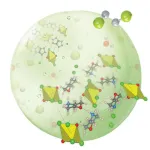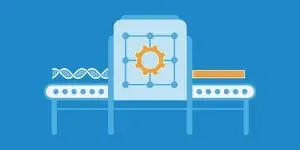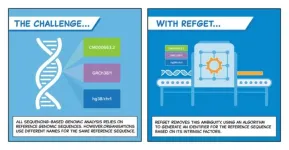(Press-News.org) UPTON, NY—Putting a suite of new materials synthesis and characterization methods to the test, a team of scientists from the University of Iowa and the U.S. Department of Energy's (DOE) Brookhaven National Laboratory has developed 14 organic-inorganic hybrid materials, seven of which are entirely new. These uranium-based materials, as well as the detailed report of their bonding mechanisms, will help advance clean energy solutions, including safe nuclear energy. The work, currently published online, was recognized as both a Very Important Paper and a Hot Topic: Crystal Engineering in Angewandte Chemie, International Edition. It will appear in July’s print issue.
While it’s important to understand what a structure is made from, it is just as important to understand what holds it together. Scientists and students from the University of Iowa, with the help of Sara E. Mason, a group leader in theory and computation at the Center for Functional Nanomaterials, a U.S. Department of Energy (DOE) Office of Science User Facility at DOE’s Brookhaven National Laboratory, and adjunct associate professor at the University of Iowa, embarked on a quest to understand and manipulate the bonds that support the structure of uranyl tetrahalide, a uranium compound.
“This study was beyond collaborative,” said study co-author Sara E. Mason. “On the synthesis side, we discovered entirely new crystal structures, which is really cool on its own. On top of that, we saw some interesting thermochemistry, the chemical energy stored in the bonds of those structures. Then there was the modeling of these structures. We could have kind of ended our study there, but Harindu Rajapaksha, the student driving this research, really wanted to push it further and use the thermochemistry and the modeling to understand these systems at a level that hasn't been possible before.”
The layers of work the team contributed resulted in a comprehensive quest to understand and manipulate the bonds that support the structure of uranyl tetrahalide, an important uranium compound. The theoretical and experimental research provided insight into the way hydrogen molecules form bonds that can stabilize these complex molecular structures, paving the way for scientists to alter them for many applications.
Uranyl Tetrahalide—the Remix
When designing hybrid materials to study, why look at uranium? For this team, the answer is both practical and personal.
“In order to effectively manage nuclear waste, we need a better understanding of issues like material separations and recycling,” said Tori Forbes, a professor and director of the Materials Analysis, Testing, and Fabrication Facility at the University of Iowa. “We need to know how uranium behaves in solids and in water, so we are probing the most basic chemistry of uranium to acquire knowledge that can be used for advanced technologies and strategies to improve the back end of the nuclear fuel cycle.”
Looking towards a future with clean energy deployed at scale, uranium is a material that has piqued a lot of scientific interest. Uranium makes up a vast majority of the byproducts from nuclear energy, which is a zero-carbon-emission energy source. Understanding the chemistry of uranium and related systems is integral for implementing nuclear energy safely and effectively. That isn’t the only intriguing aspect of this element though. Some researchers enjoy the challenge of working on such complex structures.
“I'm a chemist by training,” said Mason, “so I’m fascinated by what’s really deep in the periodic table, like uranium. The deeper you go, the more electrons you have, and the more electrons you have, the weirder, more exotic, and more exciting the electronic structure and bonding is. There's this ‘final frontier’ of the periodic table aspect to it. These are never-before-characterized structures. These are brand new! From a pure, chemical curiosity, this is all really cool.”
This work also built on the foundation of uranyl hybrid materials research that the team published in Inorganic Chemistry in 2022. Both studies used density-functional theory, a computational modelling method that uses quantum mechanics to predict materials’ electronic structure—the way electrons move in certain materials—alongside complementary methods to characterize these structures. In larger molecules, the atomic structure of a chemical system gets more complex, and more electrons are available to interact. Those interactions can make certain calculations difficult, which is why scientists rely on a few different methods to investigate the structure and properties of these systems. By building on the foundations of their previous work, the team now had enough structures to compare the theoretical work to the experiment, which limited them in the past.
Making Connections
LEGO® bricks will snap together and form a strong bond until they are pried apart. Their precisely molded plastic studs and recesses were designed to always work in the same way with all kinds of structures, opening a world of possibilities with each configuration. Molecules have a number of systems to bond atoms together. Some are melded to each other like glue, some click together like LEGO® bricks.
Non-covalent hydrogen bonds can be thought of like an electrostatic force. There is a bond donor, like the studs on the top of a LEGO® brick, that interacts with a bond acceptor, or the back of the brick where the studs fit snugly. These bonds can occur both intra- and intermolecularly, as well as between separate molecules or within the same molecule structure, which allows for all kinds of interesting molecular geometries to arise. The strength of these bonds and the energy held within the bonds change based on the structures they’re in. Understanding the properties of these variations can allow scientists to get creative and discover how to take apart and rebuild useful materials in unexpected ways.
Forbes found that these bonds were more interesting than they appeared on the surface. She explained that “non-covalent interactions (NCIs) like this are often the bonds that get overlooked because they are considered weak. However, when you combine them into a larger network, then it is the sum of these interactions that can have huge impacts on the chemistry. This is more a systems-level approach to understand the chemistry holistically. These types of network systems are incredibly important to the stability of materials and the overall behavior of uranium in water.”
“NCIs are significant in several applications, including drug development and to nuclear waste reprocessing,” explained Rajapaksha. “Our goal was to create a methodology for quantitatively characterizing the NCI network in a well-studied uranyl tetrahalide model system and describe how NCIs affect two crucial uranyl solid phase properties: vibrational and formation enthalpies?a direct indicator of a species' stability. These properties are significant because vibrational spectroscopy, a method of identifying molecules by the way they absorb light, is a frequently utilized technique for specialized methods that can identify uranyl species.”
Enthalpy is the measurement of the internal energy and pressure energy of a thermodynamic system, which determines the strength of the bonds. When broken, the energy stored in these bonds is released as heat, which can be measured through a process called calorimetry. In this process, a tool called a calorimeter measures the change in temperature that occurs when that heat is transferred out. If that word looks familiar, it’s because calorimetry determines how many calories are in food. Instead of burning materials, however, the team used acid to create a chemical reaction that broke the bonds and gave off heat. Getting the computational modeling to agree with the experimental data, however, took a bit of work.
“Rajapaksha got that to work out really nicely,” said Mason. “He had this high-quality agreement between the model thermochemistry and the measured thermochemistry. This is important because it means that we can rely on his measurements. Even if it's a system that hasn't been synthesized yet, he can model it correctly. He can trust those predictions. If we have a reliable way of calculating the thermochemistry, then we can spot trends and gain a new, more complete physical understanding of the bond, chemically speaking, which can allow us to tune and control these interactions.”
The Shape of Things to Come
While the team has learned some interesting things about uranyl tetrahalide systems, they say the most important finding is the cooperative methodology they have developed to characterize these materials. There are other complex chemical structures that the same principles can be applied to, and their applications could have world changing impacts.
“We are really thrilled about our findings,” said Rajapaksha, “and we intend to expand this work in the future to include less-explored systems, such as neptunyl. Neptunium 237, a pollutant, is a long-lived isotope that contributes to the radioactivity of spent nuclear fuels. Basic knowledge in this field would be extremely valuable to basic sciences and nuclear waste management. We have, so far, obtained pretty intriguing results by applying our methodology to the neptunyl system, which we aim to publish soon.”
This research is funded by the Department of Energy, Basic Energy Sciences program under DE-SC0021420 and the Theory and Computation facility of the Center for Functional Nanomaterials (CFN), which is a U.S. Department of Energy Office of Science User Facility, at Brookhaven National Laboratory under Contract No. DE-SC0012704. Computational resources (High Performance Computing access) were provided in part by the University of Iowa. All calorimetry measurements were performed at the University of Notre Dame. Brookhaven National Laboratory is supported by the U.S. Department of Energy’s Office of Science.
Brookhaven National Laboratory is supported by the Office of Science of the U.S. Department of Energy. The Office of Science is the single largest supporter of basic research in the physical sciences in the United States and is working to address some of the most pressing challenges of our time. For more information, visit science.energy.gov.
Follow @BrookhavenLab on Instagram, LinkedIn, Twitter, and Facebook.
Related Links
Using Computation and Theory to Enhance Nano-Agriculture and Beyond with Sara E. Mason
Coming Out is a Lifelong Process END
A non-covalent bonding experience
Scientists discover new structures for unique hybrid materials by altering their chemical bonds
2023-07-19
ELSE PRESS RELEASES FROM THIS DATE:
Research analyzes kidney functions and predictors of disease
2023-07-19
Research is shedding light on kidneys, their critical functions, and predictors of disease.
The research co-led by Matthias Kretzler, M.D. describes the creation of a cellular atlas of the kidney describing nearly 100 cell types and states. It represents the most comprehensive study of cellular states, neighborhoods, and outcome-associated signatures in the kidney.
Researchers from more than twenty institutions collaborated on this project.
Kidneys monitor and maintain the internal balance in the body, filter out ...
SARS-CoV-2 infects liver, stimulating glucose production and contributing to severe form of COVID-19
2023-07-19
Research conducted at the University of São Paulo (USP) in Brazil shows that SARS-CoV-2, the virus that causes COVID-19, can infect liver cells (hepatocytes), stimulating glucose production and leading to a condition similar to diabetes (hyperglycemia) in hospitalized patients, even if their blood sugar level was normal before they were admitted to hospital.
An article on the study is published in Proceedings of the National Academy of Sciences (PNAS). The findings describe part of the mechanism used by the virus to infect liver cells and impair glucose metabolism, and point ...
Research could pave way to greener, more sustainable products made with renewable carbon
2023-07-19
Carbon-based materials have several qualities that make them attractive as catalysts for speeding up chemical reactions. They are low-cost, lightweight and their high surface area provides a good scaffold on which to anchor catalysts, keeping them stable and dispersed far apart, while providing molecules a lot of surface area to work. This makes carbons useful for energy storage and sensors. Over the last 10 years, carbons have been used in electrochemistry to catalyze reactions to make chemicals and fuel cells.
However, ...
Unlocking the power of molecular crystals: a possible solution to nuclear waste
2023-07-19
In a world increasingly concerned about the environmental and geopolitical implications of fossil fuel usage, nuclear energy has resurfaced as a subject of great interest. Its ability to generate electricity at scale without greenhouse gas emissions holds promise as a sustainable clean energy source that could bridge society’s transition away from fossil fuels to a net-zero future. However, nuclear power generation does produce radioactive waste. The safe management of nuclear waste remains a crucial challenge that must be addressed to gain public confidence in this transformative power solution.
Now, a team of University of Houston researchers has come up with an innovative ...
refget v2.0 links the hidden dictionaries of DNA
2023-07-19
A widely-used tool that finds the exact references needed to pinpoint differences in our DNA just got a refresh.
On 17 July, the Standards Steering Committee of the Global Alliance for Genomics and Health (GA4GH) voted to release refget v2.0. With better compatibility for a range of reference genome names, formats, and systems, the new version of refget makes it easier than ever to retrieve verified genomic reference sequences.
A vital infrastructure
You may not even realise that you’re using refget already.
“Almost ...
Do certain amino acids modify the risk of dementia linked to air pollution?
2023-07-19
EMBARGOED FOR RELEASE UNTIL 4 P.M. ET, WEDNESDAY, JULY 19, 2023
MINNEAPOLIS – Higher levels of vitamin B-related amino acids may be linked to the risk of dementia associated with a certain type of air pollutants called particulate matter, according to a study published in the July 19, 2023, online issue of Neurology®, the medical journal of the American Academy of Neurology. The study does not prove that pollution or amino acids cause dementia, but it suggests a possible link among them.
Researchers ...
CHOP and Penn researchers find behavioral economics strategies can help patients quit smoking after a cancer diagnosis
2023-07-19
Philadelphia, July 19, 2023 – Researchers from Children’s Hospital of Philadelphia (CHOP) and the Perelman School of Medicine at the University of Pennsylvania found that cancer patients who continued to smoke after their diagnosis were significantly more likely to receive treatment for tobacco use when “nudges” to provide tobacco treatment were directed at clinicians through the electronic health record. The findings strengthen the case for using behavioral economics, or targeting predictable patterns in human decision-making to overcome ...
Hepatitis cases and heart valve infection deaths tied to early OxyContin marketing
2023-07-19
New Haven, Conn. — Decades after Purdue Pharma began to push physicians to prescribe addictive pain pills, the opioid crisis has been a slow-motion disaster, with overdoses destroying lives and families across the country.
Now, it appears the consequences of those early marketing efforts are even more devastating. In a new study, researchers at the Yale School of Public Health show that infectious disease rates in the United States also climbed as a direct long-term result of the marketing of OxyContin.
By ...
Treatment at the first signs of MS could mean lower risk of disability later
2023-07-19
EMBARGOED FOR RELEASE UNTIL 4 P.M. ET, WEDNESDAY, JULY 19, 2023
MINNEAPOLIS – People who start taking medication soon after the first signs of multiple sclerosis (MS) may have a lower risk of disability later, according to a study published in the July 19, 2023, online issue of Neurology®, the medical journal of the American Academy of Neurology.
MS is a disease in which the body’s immune system attacks myelin, the fatty white substance that insulates and protects the nerves. Symptoms of MS may include fatigue, numbness, ...
Teaching robots to teach other robots
2023-07-19
You’re a poker wizard. A friend knows all about French cuisine. Another friend is a Mozart expert.
The three of you get together and share knowledge about your respective expertise. Each of you leaves learning something from the other two.
People learn a lot by sharing and exchanging information. Can computers do the same with other computers—can robots, in effect, teach other robots how to learn by sharing knowledge?
A team of researchers led by computer science Professor Laurent Itti and one of his Ph.D. students, Yunhao Ge, address this question in ...
LAST 30 PRESS RELEASES:
First Editorial of 2026: Resisting AI slop
Joint ground- and space-based observations reveal Saturn-mass rogue planet
Inheritable genetic variant offers protection against blood cancer risk and progression
Pigs settled Pacific islands alongside early human voyagers
A Coral reef’s daily pulse reshapes microbes in surrounding waters
EAST Tokamak experiments exceed plasma density limit, offering new approach to fusion ignition
Groundbreaking discovery reveals Africa’s oldest cremation pyre and complex ritual practices
First breathing ‘lung-on-chip’ developed using genetically identical cells
How people moved pigs across the Pacific
Interaction of climate change and human activity and its impact on plant diversity in Qinghai-Tibet plateau
From addressing uncertainty to national strategy: an interpretation of Professor Lim Siong Guan’s views
Clinical trials on AI language model use in digestive healthcare
Scientists improve robotic visual–inertial trajectory localization accuracy using cross-modal interaction and selection techniques
Correlation between cancer cachexia and immune-related adverse events in HCC
Human adipose tissue: a new source for functional organoids
Metro lines double as freight highways during off-peak hours, Beijing study shows
Biomedical functions and applications of nanomaterials in tumor diagnosis and treatment: perspectives from ophthalmic oncology
3D imaging unveils how passivation improves perovskite solar cell performance
Enriching framework Al sites in 8-membered rings of Cu-SSZ-39 zeolite to enhance low-temperature ammonia selective catalytic reduction performance
AI-powered RNA drug development: a new frontier in therapeutics
Decoupling the HOR enhancement on PtRu: Dynamically matching interfacial water to reaction coordinates
Sulfur isn’t poisonous when it synergistically acts with phosphine in olefins hydroformylation
URI researchers uncover molecular mechanisms behind speciation in corals
Chitin based carbon aerogel offers a cleaner way to store thermal energy
Tracing hidden sources of nitrate pollution in rapidly changing rural urban landscapes
Viruses on plastic pollution may quietly accelerate the spread of antibiotic resistance
Three UH Rainbow Babies & Children’s faculty elected to prestigious American Pediatric Society
Tunnel resilience models unveiled to aid post-earthquake recovery
Satellite communication systems: the future of 5G/6G connectivity
Space computing power networks: a new frontier for satellite technologies
[Press-News.org] A non-covalent bonding experienceScientists discover new structures for unique hybrid materials by altering their chemical bonds


